


In the past, we’ve both reviewed cocktail books and chronicled the drinking history of towns from Washington D.C. to Buffalo. Now, from the minds of award-winning journalist Cody McDevitt and legendary Pittsburgh bartender Sean Enright, we have the rare pleasure of shedding light onto a book that is both. Pittsburgh Drinks: A History of Cocktails, Nightlife and Bartending Tradition is not only a comprehensive history of 150 years of Pittsburgh speakeasies, clubs, and cocktails but also contains local recipes from bartenders young and old, famous and up and coming, from Enright himself to cocktail legend and Pittsburgh native Phil Ward.
Here’s a look at what we found within:
In the run-up to Prohibition, Pittsburgh one of the most unabashedly liquored up towns in the country. Hundreds of speakeasies served patrons in locales ranging from darkened alleys to private penthouses to the coat sleeves of clever panhandlers. It’s a history that seems so audacious that it must belong to a pulp novel or crime serial rather than a history book, but tales of mafiosos, clever cops, brawling brewers, and of course crooked politicians flow freely from the pages of Pittsburgh Drinks like beer from tap line.
Enright and McDevitt walk us through the booming age of jazz clubs, through the fight to include women and people of color in bartenders unions, from heady times full of joy, verve, and drinking with celebrities to the more somber eras of World War II and how war abroad changed the way bars and clubs ran at home. We see how those changes in turn molded Pittsburgh into the beautiful and lively city that it is today.
We’re taken through the lounge scene, disco fever, Pittsburgh’s mid nineties craft cocktail resurgence, and how their resplendent craft beer scene is encouraging a rebirth of and growth in neighborhoods all over the city. It’s a thrill to learn the history of places we’ve loved to visit, like the Church Brew Works, a craft brewery and restaurant built out of a beautiful and sprawling cathedral, literally placing the beer they make on an altar. This is a book that takes a history that is fascinating to us drink nerds, and connects it to the larger story of the city it serves, and it creates a greatly fulfilling experience.
That said, it wouldn’t do to talk about only half of the book. Here are a few of the cocktails we sampled from Pittsburgh Drinks, sure to be the first of many.
One of the first famous custom cocktails to come out of Pittsburgh, the Fussfungle dates as far back as the late 1800’s. A drink that the Mayor of McKeesport, the town in which the drink was invented, preached against and which was said to start fights in church. This one continues our love of freshly making the ingredients in house, and happily provides a recipe for Burnt Brown Sugar-Molasses Syrup, which once prepared is added to Rittenhouse Rye.
The result is a spicy sweet blend whose bite, while still present, is somewhat masked by the sweetness of the sugar syrup. The brown sugar syrup pairs very well with the natural citrus and cinnamon of the Rittenhouse, and one can see its popularity soaring in as wet a town as pre-prohibition Pittsburgh. And as much a fan as I am of gin, the Mayor loses points for speaking against this wonderfully smooth cocktail with the unique and memorable name.
Speaking of a love of gin, next up we have the Hattori Hanzo, whose eye-catching name and list of ingredients made this one a must test. Nowadays, Hanzo is probably most easily recognized as the swordsmith who crafts The Bride’s deadly blade in the Kill Bill movie series. Hanzo, however, was also a real historical man and legendary ninja who once saved the life and assisted in the rise of one of the last Shogun rulers of Japan.
This cocktail pays tribute to the name with the use of yuzu juice, a Japanese citrus that is less tart than the more commonly used lemon or lime. Additionally, sherry and demerara sugar are added to sweeten the drink and work with the tartness of crabapple cider. The resulting cocktail is sweet, lightly tart, and the fruity ingredients blend masterfully with the more caramel-like sugar in the raw along with citrusy notes of gin.
As someone who grew up in a former steel town whose fate was tied to the rivers that ran through it we Buffalonians, and I can wager people all across the nation, can find a lot in common with a city like Pittsburgh. It’s a town as ready to cut loose as it is to clock in. A city whose culture, while not always immediately evident to outsiders, reveals its rich breadth and depth with warmth, welcome, and aplomb.
Enright and McDevitt have here delivered us a brief view into that world, with its warts and wonders all laid before them. Pittsburgh Drinks may not be the weighty and powerfully built tome of say, The Death & Co. Drinks Manual, but the substance found within is, much like their drinks, every bit as heartening. It’s a drink happily and thankfully shared.
For more cocktail book reviews, keep up with the BevSpot blog by creating your own free community account. You’ll get updates on the latest articles as well as gain access to our exclusive tools and guides.
Schedule 15mins to chat with a product specialist
Start a FREE Trial Today! BevSpot offers full product education and account setup for all customers! No card Information needed!
